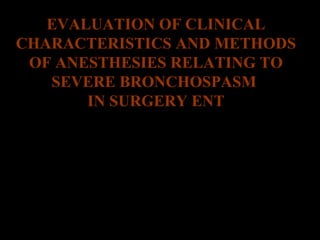
EVALUATION OF BRONCHOSPASM MANAGEMENT IN ENT SURGERY
- 1. EVALUATION OF CLINICAL CHARACTERISTICS AND METHODS OF ANESTHESIES RELATING TO SEVERE BRONCHOSPASM IN SURGERY ENT PRESENTATION: DR.Nguyen Phu Van ENT Hospital National
- 2. Introduction Bronchospasm is caused by the spasmodic contraction of the bronchial smooth muscle. Occur during periods of anesthesia Incidence: 1,7‰ in patients without a history of asthma 8 ‰ in patients with a history of asthma 30% in patients with severe asthma Incidence decreases with age Pedersen,ActaAnaesthesiol Scand2001
- 3. Introduction Risk of bronchospasm increase10 times when a respiratory infection. - Patients with ENT infections : flu, allergic rhinitis… - Tracheal stenosis, dyspnea, accumulation of sputum, pneumonia … Olsson, ActaAnaesthesiol Scand 2007 Severe bronchospasm may be at risk of hypoxic brain, cause brain damage or brain death. In cases of severe bronchospasm : 70% death 18% hypoxic brain Cheney, Anesthesiology 1991
- 4. For these reasons that we do this research aims : 1.Evaluate the clinical characteristics related to severe bronchospasm in ENT surgery. 2.Methods of anesthesia-related bronchospasm 3.Evaluate the results of treatment of bronchospasm severe.
- 5. Obstructing air exhaled Gas trapping Excessive alveolar stretch alveolar increased pressure Literature review Pneumothorax alveolar rupture
- 6. Obstructing air exhaled gas trapping Excessive alveolar stretch Reduced lung compliance alveolar increased pressure Reduced circulation back to the heart Disorders of blood-gas distribution Increased pulmonary artery pressure literature review Pneumothorax alveolar rupture
- 7. Obstructing air exhaled gas trapping Excessive alveolar stretch Reduced lung compliance alveolar increased pressure Mobilization of auxiliary respiratory muscles Increased respiratory activity Increased production of CO2 Reduced circulation back to the heart Disorders of blood-gas distribution Hypotension Hypoxemia Acute heart failure Increased pulmonary artery pressure Increased right ventricular load Increased oxygen consumption literature review Pneumothorax alveolar rupture
- 8. Sonde, tube Mechanism of bronchospasm General anesthesia Central nervous system Bronchial smooth muscle Local anesthesia The stimulation of surgery Stimulate, traction, The vagus nerve Bronchial parasympathetic ganglion rub Epithelium trachea The gases, exudates, blood or bronchi Increased bronchial response BRONCHOSPASM
- 9. DEEP ANAESTHESIA Sonde, tube Mechanism of bronchospasm General anesthesia Central nervous system Bronchial smooth muscle Local anesthesia The stimulation of surgery Stimulate, traction, The vagus nerve Bronchial parasympathetic ganglion rub Epithelium trachea The gases, exudates, blood or bronchi Increased bronchial response BRONCHOSPASM
- 10. Management of bronchospasm Stop all stimulation on patients Ventilate the patient with 100% oxygen Assess whether anaphylaxis is not? Yes Management of anaphylaxis Deep anesthesia Not Normotensive: Propofol IV Sevofluran Hypotension: Ketamine IV Optimal ventilation Control of the airway by intubation pressure control ventilation with prolonged exhalation time : I/E= 1/3, 1/4 Manual ventilation with 100% oxygen Use bronchodilators Salbutamol spray Intravenous bronchodilator : Salbutamol, Diaphyline If shock or use of bronchodilators failure: Adrenalin IV Solu-medrol IV
- 11. Research Methodology - Study design : Retrospective, descriptive, cross-sectional. At the Department of Anesthesiology and Resuscitation Emergency Department, ENT Hospital National, within 15 years, the period from January 1999 to January 2014. - Subjects of study : The patient had been diagnosed with severe bronchospasm
- 12. RESULTS Clinical characteristics and type of anesthesia Characteristics Age <18 years old: 1 18-60years old: 13 > 60years old : 3 Sex Males: 12 Females: 5 Period Intraoperative: 15 Intubation: 1 Extubation: 1 Diseases need surgery Tracheal stenosis: 13 Sinusitis: 1 Neck abscess: 1 Open glottis paralysis: 2 Type of anesthesia Local anesthesia: 15 General anesthesia:2 Cause Stimulation of surgery: 14 Reflux: 2 Drug reactions: 1
- 13. Symptoms Signal Quantity Ratio % Subjective symptom Intense dyspnea 17 100% Tachypnea 3 Bradypnea 15 88,2% Stiffened body 12 70,5% Objective symptom Auscultation Murmur decreased alveolar 17 100% Wheezing 13 76,4% Lung silence 4 Perception Vague 12 41,2% Tumbledown 5 29,4% Heart rate Tachycardia 10 58,8% Bradycardia 7 41,2% Blood pressure Normotensive 2 Hypotension 15 88,2% SpO2 >90% 2 47% 50-90% 10 <50% 5 29,4% Pneumothorax Unilateral 3 Bilateral 12 70,5%
- 14. Results of treatment Emergency Management General anesthesia, using bronchodilators, support 100% oxygen through the tube (17/17), tracheostomy set canuyl 14/17 patients, 3/17 patients intubation.. After the emergency management Pleural drainage and continuous suction, 15/17 patients. Sedation, pressure control ventilation, antibiotics, anti-inflammatory Outcome •12/17 patients recover completely and do not leave sequelae •2/17 patients were treated early and properly position the principle has recovered immediately. •3/17 patients died.
- 15. DISCUSSION Clinical characteristics and type of anesthesia -13/17 (76.5%) tracheal stenosis scarring need to tracheostomy for airway control under local anesthesia. -According to Nathalie Schutz, the incidence rate of bronchospasm met 80% of the patients with airway obstruction and surgery without anesthesia. -Study on 31 patients who had surgical tracheostomy under local anesthesia by the author Rohail Ahmed, Muhammad Faheem Malik, the 2 patients with pneumothorax, 2 patients with cardiac arrest due to bronchospasm.
- 16. The stage and cause of bronchospasm The stages R N Westhorpe Our Induction 48 1 Perioperative 66 15 Postoperative 11 1 Total 125 17 Causes Stimulates airway 23 15 Drug reactions 8 1 Early extubation 6 1 Other causes 5 0 Total 42 17
- 17. Results of treatment -2/15 patients received early treatment were stable and without complications - 70% (12/17 patients) were pneumothorax were treated for pleural drainage continuous suction with negative pressure, pressure control ventilation, sedative, analgesic, antibiotic, anti-inflammatory and has stable after 5- 7 days. -3/17 patients died.
- 18. CONCLUSIONS - Complications severe bronchospasm in ENT surgery met the majority of patients with tracheal stenosis scarring require surgery tracheostomy under local anesthesia (accounting for 76.5%). - 88.2% (15/17) patients with severe bronchospasm were pneumothorax and 3/17 patients died due to delays and improper management principles. - 2/17 patients received timely and proper management principles, has recovered completely without complications.
- 19. Thanks for your attention!
